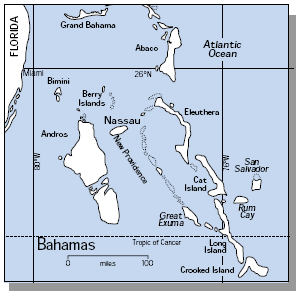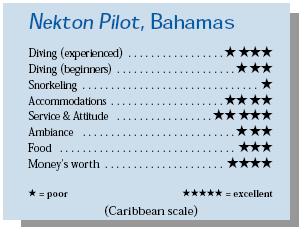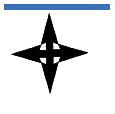Doing the Bahamas in a BoxContents of this Issue: Do Repetitive Flights Up Your Odds of the Bends? Swirls and Surges in the California Kelp What Equipment is Hot and What’s Not at DEMA American Deaths Lead Aussies to Control Diving? Editorial Office: Ben Davison Publisher and Editor Undercurrent 3020 Bridgeway, Suite 102 Sausalito, CA 94965 diving from a floating resort, the Nekton Pilot from the March, 1999 issue of Undercurrent
One thing’s for sure: the Nekton Pilot is one unique, even weird, boat. She’s more than boxy--almost truly rectangular-- but because the bow is never in the water, she doesn’t need a sleek prow to cut through the waves. The three-story tall, 40-foot by 78-foot platform sits on two submerged pontoons--really two 65-foot long steel torpedoes filled with engines, fuel, purified water, sewage, and air. Relief Captain Skip Evans moves air and liquid around in the tubes to keep the boat level, stable, and above the mottled surface of the rolling ocean. Designed to minimize the rolling that can lead to widespread mal de mer, the boat rides like a cradle instead of a “bobbing bottle.” She’s not purely stationary, however, and in the channel crossing the guests quickly learned to dance the Nekton Shuffle. A few people felt nauseous, but we landlubbers had no serious complaints. Come to think of it, the Nekton Pilot’s not a boat: it’s a floating dedicated dive resort, built to move short distances at all of nine knots. The odd design, however, translates into greater diver comfort. The accommodations were excellent: sixteen reasonably quiet staterooms, each with large windows, a shower, toilet, and enough shelf and hanging space for stowing the little clothing necessary given the 80° days and 70° nights we had on this December trip. Of course, a comfortable craft does not a good dive trip make, and the question remained: would this itinerary measure up? Actually, the Pilot has three distinct itineraries--
Western Bahamas, Cay Sal Banks, and Southern Bahamas--each
offered at different times of the year. The southern itinerary dived the more remote areas in the Bahamas, and the sites there had been prepared by the Nekton folks with moorings. Most dives were deep, along sheer, nearlyvertical walls that started at 60 feet, many with chutes and swimthroughs emptying at 110-120 feet. I wanted to see the sharks of the Bahamas, and they showed up on the very first dive: two curious six-footers, accustomed to being fed when they hear the engines. Yet the spectacular walls were the main show. Gliding through coral gardens with 80 to 200-foot visibility in water as transparent as blue sky, the perpendicular drop into the depths took my breath away. Undulating curtains of reef fish poured down, veiling the wall. An occasional hammerhead or reef shark flickered across the backdrop. Schools of hunting jacks swam among the black coral trees and lush soft corals, corals that, unfortunately, showed signs of bleaching and encroaching disease. Devil’s Claw, off San Salvador, was typical. Ubiquitous Nassau groupers kept track of everything moving on their reefs in the 80° water, crowding out the smaller tiger groupers at every opportunity. Queen triggers flitted around. A nurse shark lay in a sand channel, hiding his head under the ledge. Along the top, flamingo tongues posed on sea fans punctuating the coral gardens. Off Rum Cay we had the only shallow dive on this itinerary. No more than 40 feet deep, Snowfields was overrun with little yellow stingrays, juvenile seabass, tiny gold-spotted eels, and lots of cleaning stations where the parrotfish and groupers gathered to get preened. Only one location, the one we dived the final day, had decent snorkeling, but this may have been deliberate: they polled the guests at the beginning of the trip, and we expressed little interest in snorkeling. Five dives are available daily: two on each site, with the afternoon site serving as the night dive location. The Pilot moved at night to the next morning’s site, then again during lunch. Dives were on the honor system; they asked us to buddy-dive and to refrain from drinking alcohol until ending the dive day. No one preached about safety or carrying too much weight, and long safety stops were easy with a stable hang bar at 15 feet, an emergency tank waiting next to the bar. The main restriction was not to go below 130'. If I couldn’t find a buddy, a staff member would willingly gear up and go along. At each site, the staff gave thorough briefings replete with schematics and information on current. Each diver had his own seat on the deck and his own steel 95 tank (a few smaller tanks were available). To avoid crowding, divers staggered schedules for dressing and entry. During dives, they stationed one crew member on the dive deck while another watched from the top deck for divers in trouble. Everyone was computerized, and a sign-out and sign-in log allowed the crew to check each diver’s profiles. All the staff, most of whom were instructors, were personable, knowledgeable, and patient. When along on dives, they pointed out critters, but they were not there to watch everyone, and some took photos.
But the crew member I’m usually most interested in patrols the galley, and chef Jerra seemed to live there, baking fresh bread, making ceviche, and rearranging the freezers as she drew down the stock. She rotated the breakfast menu daily: French toast, pancakes, or scrambled eggs, along with oatmeal and homemade bran muffins. Fresh fruit held out for the whole week and fresh salads until Thursday. Lunch consisted of sandwiches, always soup, maybe a pasta salad. Dinner featured prime rib, pork loin, or chicken, but fish was available, and she catered to special diets for some guests. The meals were not “gourmet,” and the selection was limited, but they were commendable, and no guest left without a full tank. And there were snacks: cookies fresh from the oven at 10 a.m., egg rolls or hot wings at 4, and popcorn at night during movies. Beer, wine, and drinks were sold, but most guests had visited the liquor store in Georgetown before sailing and stored their six-packs and bottles of Chardonnay in an ice-filled cooler on the photo deck. Georgetown isn’t much of a town, and one spends the first night on the Pilot as the crew readies the boat for a Sunday dawn departure. We passed time reading, watching videos, or getting to know one another in the adjoining dining room and salon or on the upstairs sundeck. Each night there were slide shows on marine life, most of which were attention-getting and information-packed. After four years in the water, a few of the Pilot’s rough edges are beginning to show. The staterooms could use some new mattresses, linens, and a thorough cleaning. It might also be time to refit some amenities, such as the carpeting in the rooms and the upholstery in the common areas, although these areas did smell fresh: boat rules require all wet gear and towels to be hung in the ample storage space on the sundeck. Most guests had been on the boat for at least one of its other itineraries. Despite the profusion of sea life, all the repeaters said, “It’s not as good as Cay Sal Banks or the western Bahamas.” While those comparisons were somewhat of a wet blanket, I thought the diving good enough to make 22 dives during the 5-1/2 days--and to give it 4 out of 5 stars on a Caribbean scale. But hey, maybe those repeaters knew what they were talking about. Next winter, the Pilot will be stationed in Belize. The move may be engendered because the company hopes the next Pilot will be in the water by then (Andy, the engineer, is a marine engineer who’s developing the design) or because there’s a better itinerary lurking out there. Will I become one of the repeaters? Their innuendo was infectious, the sharp plunge of vertical walls draped with rippling reef fish always somehow falling short of those they’d seen on those tantalizing other itineraries. The towering superstructure of the boat is hardly pleasing to the eye but does dampen those stomach-flipping swells and rolls, and I’m intrigued by Andy’s challenge of designing an even better craft. The Belize junket holds the allure of an untried itinerary (though the Aggressor and Dancer may have already picked the best spots), and the pleasant summer tours on their top-billed western Bahamas and Cay Sal Banks sojourns promise topnotch trips. It’s one of those things I’ll keep in the back of my mind. — N.M.
|

I want to get all the stories! Tell me how I can become an Undercurrent Online Member and get online access to all the articles of Undercurrent as well as thousands of first hand reports on dive operations world-wide
| Home | Online Members Area | My Account |
Login
|
Join
|
| Travel Index |
Dive Resort & Liveaboard Reviews
|
Featured Reports
|
Recent
Issues
|
Back Issues
|
|
Dive Gear
Index
|
Health/Safety Index
|
Environment & Misc.
Index
|
Seasonal Planner
|
Blogs
|
Free Articles
|
Book Picks
|
News
|
|
Special Offers
|
RSS
|
FAQ
|
About Us
|
Contact Us
|
Links
|
3020 Bridgeway, Ste 102, Sausalito, Ca 94965
All rights reserved.

 Georgetown, Great
Exuma, was the launching location for my southern tour,
which took us to Conception Island, Cat Island, San Salvador, Rum Cay, and back to Conception, about
300 miles in six days.
Georgetown, Great
Exuma, was the launching location for my southern tour,
which took us to Conception Island, Cat Island, San Salvador, Rum Cay, and back to Conception, about
300 miles in six days. Though the Pilot holds 32 guests,
only 29 were on my trip--all Americans--
along with 12 crew members. The
captain, first mate, and engineer
were just as obliging as the
divemasters. It was a remarkably
well-run operation, and the crew was
a well-trained, amiable, and welleducated
bunch, many working on masters
in marine biology.
Though the Pilot holds 32 guests,
only 29 were on my trip--all Americans--
along with 12 crew members. The
captain, first mate, and engineer
were just as obliging as the
divemasters. It was a remarkably
well-run operation, and the crew was
a well-trained, amiable, and welleducated
bunch, many working on masters
in marine biology. Diver’s Compass: Nekton Pilot, contact 800-899-6753 or 954-463-
9324, fax 954-463-8938, e-mail
Diver’s Compass: Nekton Pilot, contact 800-899-6753 or 954-463-
9324, fax 954-463-8938, e-mail 